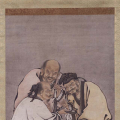Welcome home! Please contact lincoln@icrontic.com if you have any difficulty logging in or using the site. New registrations must be manually approved which may take several days. Can't log in? Try clearing your browser's cookies.
Theravadan Artwork?
 Jeffrey
Veteran
Jeffrey
Veteran
I've seen a lot of Japanese and Tibetan artwork, but I was unable to find any in the Theravadan tradition. I thought of this in the Self or no-Self thread as the topic came up comparing depictions of Buddha in Tibetan art to depictions of Krishna in Indian. I wanted to see Theravadan artwork so I can know how they are inspired spiritually.
0

Comments
All the best,
Todd
http://www.abhayagiri.org/gallery/presentation/1329/
I've seen this painting and others in a Theravadan Buddhist temple. This is one of several. It belonged to a series that depicted the Buddha's life. It's about 3'x 5'. I'm not sure if its "Theravadan", but nice artwork..
http://www.allmyanmar.com/new allmyanmar.com/myanmar art.htm
Zenff I like these more ornate works. Thanks.
It is noticeable that the artworks do not include the "Buddha image" or "Buddha rupa"
The artwork uses symbols for the Buddha, such as 'the bodhi tree' or 'a wheel' or 'an empty footprint'
Pre-iconic phase (5th century - 1st century BCE)
During the 2nd to 1st century BCE, sculptures became more explicit, representing episodes of the Buddha’s life and teachings. These took the form of votive tablets or friezes, usually in relation to the decoration of stupas. Although India had a long sculptural tradition and a mastery of rich iconography, the Buddha was never represented in human form, but only through Buddhist symbolism. This period may have been aniconic.
This reluctance towards anthropomorphic representations of the Buddha, and the sophisticated development of aniconic symbols to avoid it (even in narrative scene where other human figures would appear). This tendency remained as late as the 2nd century CE in the southern parts of India, in the art of the Amaravati School (see: Mara's assault on the Buddha). It has been argued that earlier anthropomorphic representations of the Buddha may have been made of wood and may have perished since then. However, no related archaeological evidence has been found.
http://en.wikipedia.org/wiki/Buddhist_art
Looks very hot in the coconut grove hehe